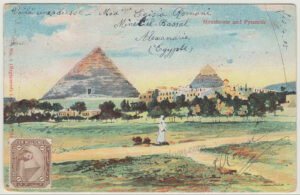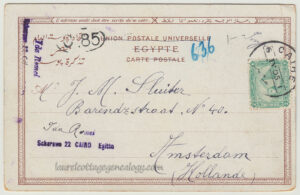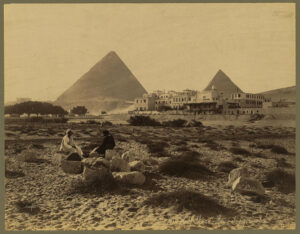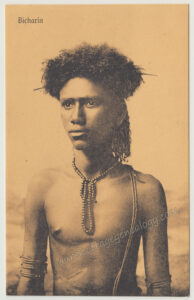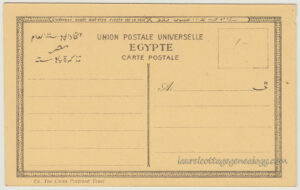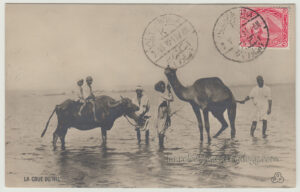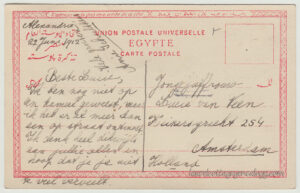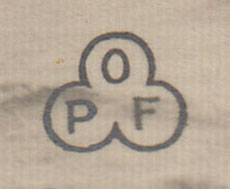Undivided back postcard. Postmarked April 6, 1905, Cairo, Egypt. Artist unknown. Publisher: Lichtenstern & Harnel. Stamps: Used Deux Milliemes, Sphinx and Pyramid, Green; Unused Un Millieme, Sphinx and Pyramid, Brown. Enlarge images to view condition for stamps.
Price: $30.00
An unknown artist’s tableau of Mena House, a luxury hotel established in 1886, with the Pyramids of Giza behind it. Closer to us in the scene, the figure of a white-robed Egyptian standing next to a dirt road.
For comparison, a photo below, retrieved from the Library of Congress website, and taken from almost the same angle, but a little closer in:
The postcard is addressed to: “M. J. M. Sluiter, Barendzstroat No. 40, Amsterdam (Hollande)”
The sender wrote: “Voilà une adresse – Madme[Madame?] Egizia Romani. Minet-el-Bassal. Alexandrie (Egypte) Ida Romei”
So, it’s kind of funny but “Egizia Romani” translates from Italian as “Egyptian Romans.” This leads us to think that maybe this was part of the street or district address, rather than a name. But not necessarily, as Egizia is an Italian given name and Romani an Italian surname. What appears to be “Madme” then might be an incorrectly written abbreviate for Madame (Mme), since French is likely not the sender’s native language. (Ida’s an Italian living in Egypt, writing in French, to someone in the Netherlands. I love these types of criss-crossed connections across the globe!) The fact that Ida Romei had a stamp for her name and address (Ida Romei, Scharawe 22 Cairo Egitta – showing on the reverse) is unusual and may indicate she was a woman of some means.
Minet El-Bassal is a district in Alexandria, on the western harbor, that was built around 1810 and became famous as an industrial and trade center for Egyptian exports, including grains, sugar and most notably, Egyptian cotton. At the time this postcard was sent, in 1905, it was certainly prospering. It is one of numerous places on the planet that for economic and political factors had later fallen into terrible decline, with somewhat recent studies showing online regarding hopeful proposed revitalization. We’d be interested to hear from any readers who might be able to give us any up-to-date information.
A last thought: In typing the above, the term “urban decline” of course comes to mind. But I wonder how easy it’s become to name something and then become blasé or cynical about it, in part, because it has been “categorized.” As in, we learn to react to the words and become indifferent to the events.
Sources: “Mena House Hotel (1886)”. Historic Hotels of the World: Then and Now. https://www.historichotelsthenandnow.com/menahousegiza.html. (Accessed June 23, 2022).
Maison Bonfils, photographer. Hotel Mena-House et pyramides / Bonfils. Egypt Jizah Jīzah, None. [Between 1867 and 1899] [Photograph] Retrieved from the Library of Congress, https://www.loc.gov/item/2004666753/.
Minet El-Basal, Alexandria, Egypt: Urban Revitalization. https://www.behance.net/gallery/37446209/Minet-El-Basal-Alexandria-Egypt-Urban-Revitalization. (Accessed June 23, 2022.)

